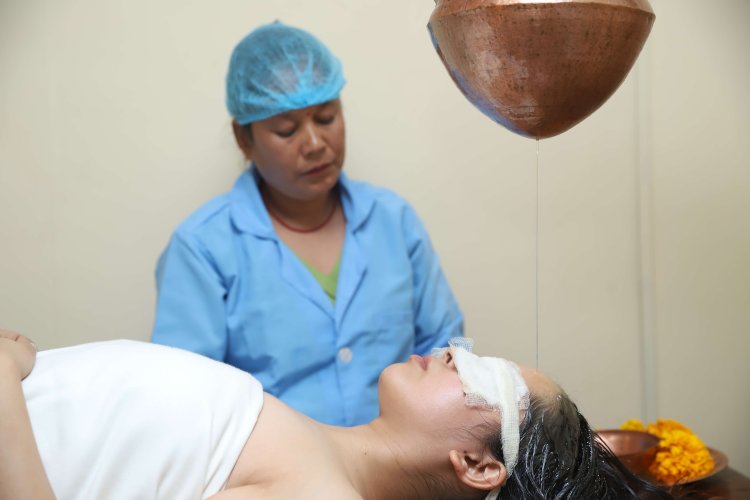Shirodhara in Nepal: A Holistic Journey to Tranquility
Discover holistic wellness through Shirodhara in Nepal at Arogya Nepal, set amidst Nepal's serene landscapes. Elevate your well-being with skilled Ayurvedic therapists and embrace rejuvenation.

Nestled in the heart of the Himalayas, Nepal is a land of serene landscapes, ancient traditions, and spiritual awakening. It's a place where seekers of wellness, both physical and mental, can find solace. One such wellness gem is Shirodhara in Nepal, an Ayurvedic therapy that promises a soothing escape from the hustle and bustle of modern life. In this article, we delve into the world of Shirodhara, exploring its origins, benefits, and how you can experience it in the enchanting landscapes of Nepal.
Understanding Shirodhara
Shirodhara is a Sanskrit term that combines "Shira" (head) and "Dhara" (flow). It is a classic Ayurvedic therapy that involves a continuous and rhythmic pouring of warm herbal oil over the forehead. This ancient practice has its roots in Ayurveda, the traditional system of medicine from India that focuses on holistic well-being. The warm oil, often infused with healing herbs, flows in a gentle stream onto the "third eye" region, creating a profound sense of relaxation and rejuvenation.
The therapeutic effects of Shirodhara are manifold. It is known for its ability to alleviate stress, promote sound sleep, and bring relief from a range of conditions, including anxiety, insomnia, fatigue, stress, and tension. But what makes Shirodhara in Nepal truly special is the way it blends the physical and spiritual, making it a holistic experience.
The Shirodhara Variations
Shirodhara is not a one-size-fits-all therapy. It offers different variations tailored to individual needs and health conditions. These variations are:
-
Tailadhara:
This is the classic form of Shirodhara, where warm medicated oil is used. The choice of oil is often customized based on your Ayurvedic constitution, or dosha. -
Takradhara:
In this variation, medicated buttermilk (takra) is poured gently over the forehead. Takradhara is particularly effective for conditions like blood pressure management and dryness of the mouth. -
Kashayadhara:
Here, specific Ayurvedic concoctions or decoctions are used for the flow. The choice of concoction depends on the health or disease condition of the recipient. -
Ksheeradhara:
This variation involves the use of medicated milk. Ksheeradhara is recommended for those experiencing insomnia, headaches, and mental tension.
These variations allow Ayurvedic practitioners to tailor the Shirodhara treatment to your specific needs, ensuring that you receive the most effective therapy.
The Benefits of Shirodhara
Shirodhara is renowned for its numerous physical and mental benefits, making it a sought-after therapy for those seeking a holistic approach to well-being. Some of the key advantages include:
-
Relaxation of Mind and Body:
The continuous flow of warm herbal oil or other liquids onto the forehead induces a deep sense of relaxation. It calms the nervous system and promotes a state of tranquility that can be challenging to achieve in our fast-paced lives. -
Increased Energy:
Shirodhara not only relaxes but also rejuvenates. The therapy helps in increasing energy levels and mental clarity, making it an excellent choice for those feeling mentally fatigued. -
Reduction of Shoulder and Neck Pain:
The soothing effect of Shirodhara extends to the muscles and joints of the shoulder and neck region. It can provide relief from pain and tension in these areas, making it a valuable therapy for those who experience chronic discomfort in these areas. -
Opening the Third Eye:
In the context of spirituality, the "third eye" is often associated with increased awareness and intuition. Shirodhara's continuous flow on the forehead is believed to open this spiritual gateway, enhancing your spiritual journey. -
Improved Sleep:
For those struggling with sleep-related issues such as insomnia, Shirodhara can be a game-changer. The therapy promotes sound sleep and can significantly enhance the quality of your rest.
Shirodhara in the Context of Ayurveda
In the ancient system of Ayurveda, it is believed that mental diseases are closely linked to Vata dosha, one of the fundamental components of the body. The vitiation of Vata is considered the primary cause of mental disorders. Shirodhara, with its calming and grounding effects, is used to pacify aggravated Vata, making it an integral part of Ayurvedic treatment.
When to Have Shirodhara
Shirodhara is indicated for conditions that exhibit symptoms similar to anxiety disorders, mental exhaustion, epilepsy, depression, phobias, insomnia, chronic headaches, and other neurobehavioral disorders. However, it's not limited to these specific conditions. Shirodhara can also be recommended for general relaxation and to enhance practices like meditation.
Contraindications of Shirodhara
While Shirodhara is a gentle and effective therapy, there are some cases where it should not be administered. These include:
- Fever
- Nausea and vomiting
- Skin diseases in the region of the head and scalp
- Alcohol intoxication
- Recent neck injuries
For individuals with high levels of anxiety, it is essential to provide proper counseling before initiating the therapy. Shirodhara should be administered with care and consideration for the individual's specific condition and needs.
How Shirodhara Works
Scientific studies on Shirodhara have revealed a common hypothesis regarding its mechanism of action. When warm oil is poured onto the forehead, it produces mechanical stress waves that stimulate neurological signals through the activation of tactile and thermo-receptors. This stimulation also activates certain areas of the frontal lobe and limbic system of the brain.
These phenomena lead to the release of endorphins and serotonin, promoting a sense of well-being and relaxation. Additionally, the constant, soothing pressure on the forehead lowers the sympathetic tone, resulting in physiological changes such as decreased heart rate, reduced blood pressure, and a calming effect.
Who Can Benefit from Shirodhara
Shirodhara is a versatile therapy with broad-ranging benefits. It can be particularly beneficial for those experiencing the following conditions:
- Stress and anxiety
- Insomnia
- Chronic headaches
- Memory loss
- Skin disorders like psoriasis
- Hypertension
- Emotional imbalances
- Depression
- Schizophrenia
For men, stress management through Shirodhara can also address issues like premature ejaculation. Additionally, the use of oil in Shirodhara nourishes the hair and scalp, preventing premature hair loss and graying.
Preparing for a Shirodhara Session
Before your Shirodhara session, it's essential to prepare for the experience:
- Wear comfortable clothing: You'll need to be in comfortable attire for the session. Loose-fitting clothing is ideal.
- Empty stomach: It's recommended to have a light meal a few hours before your session. Avoid heavy or rich foods immediately before the therapy.
- Relax your mind: Clear your schedule for the day and create a peaceful environment for yourself. Engage in relaxing activities like reading or gentle yoga to prepare your mind.
- Hydrate: Drink plenty of water to stay hydrated. This ensures a comfortable experience during the therapy.
The Shirodhara Session
Your Shirodhara session typically begins with an Abhyangam, an Ayurvedic body massage that sets the stage for deep relaxation. Here's what you can expect during the Shirodhara session:
- Prepare to lie down: You'll be asked to lie down on a comfortable massage table with your eyes closed. The therapist will ensure you are in a relaxed position.
- Oil massage: Before the pouring begins, the therapist may provide a gentle oil massage on your head or even your entire body to enhance relaxation.
- The pouring of warm oil: The therapist will position a vessel containing warm herbal oil above your forehead. The oil flows in a continuous, rhythmic stream onto your forehead. The therapist maintains an oscillating motion to ensure even coverage. The duration of the therapy can range from 30 to 60 minutes, depending on your specific condition and needs.
- Mild head massage: During or before the Shirodhara, you may also receive a mild head massage, enhancing the therapeutic effects.
- Variations: Depending on your condition, the therapist may use medicated buttermilk, decoctions, or even water in place of oil for the therapy.
It's crucial to note that Shirodhara is an intricate therapy and should be performed by experienced and qualified Ayurvedic practitioners to ensure safety and effectiveness.
After the Shirodhara Session
After the completion of the therapy, you'll be guided to sit comfortably on the table. The therapist will ensure that any excess oil on your head is cleared properly. Following the session, it is advisable to take a warm medicated bath or shower. Some practitioners may also use ghee for internal oleation, further enhancing the therapeutic benefits of Shirodhara. It is important not to engage in excessive physical or mental exertion immediately after the session, as the effects of Shirodhara continue to unfold.
Shirodhara in Nepal
Nepal, a land known for its mesmerizing landscapes and rich spiritual heritage, provides an enchanting backdrop to experience the rejuvenating practice of Shirodhara. Amidst the tranquil environment of this Himalayan nation, a unique opportunity awaits you to elevate your well-being, and it's offered by none other than Arogya Nepal.
In Nepal, you'll discover a myriad of Ayurvedic hospitals and clinics that offer Shirodhara therapy. Among these, Arogya Nepal stands out as a beacon of wellness. Arogya Nepal boasts a team of skilled Ayurvedic trainers and therapists who are experts in conducting various Shirodhara sessions.
These carefully crafted sessions at Arogya Nepal go beyond relaxation; they are a gateway to rejuvenation and profound well-being. Whether you are a seasoned practitioner of Ayurveda or someone new to the holistic approach of wellness, Arogya Nepal welcomes you to connect with the ancient wisdom of Ayurveda and embark on a transformative journey that will leave you refreshed and revitalized.
Conclusion
Shirodhara is more than just a therapy; it's an ancient art that holds the potential to soothe your mind, energize your body, and open the doors to profound relaxation and self-discovery. In the picturesque landscapes of Nepal, you can embark on a holistic journey to tranquility through the practice of Shirodhara. It offers a unique blend of physical and spiritual benefits, making it a valuable addition to your wellness journey. Consider Shirodhara in Nepal as a gateway to relaxation, inner peace, and rejuvenation, and let the healing touch of Ayurveda guide you to a state of profound well-being.
Experience the harmony of body, mind, and spirit through Shirodhara in Nepal and let the tranquil beauty of this Himalayan nation enhance your journey to holistic wellness.
Frequently Asked Questions (FAQ)
-
What is Shirodhara?
Shirodhara is a classic Ayurvedic therapy that involves the continuous pouring of warm herbal oil (or other liquids) over the forehead. The name combines "Shira" (head) and "Dhara" (flow). -
What are the variations of Shirodhara?
Shirodhara offers different variations tailored to individual needs, including Tailadhara (medicated oil), Takradhara (medicated buttermilk), Kashayadhara (Ayurvedic concoctions), and Ksheeradhara (medicated milk). -
What are the benefits of Shirodhara?
Shirodhara is known for its ability to alleviate stress, promote sound sleep, reduce pain in the shoulder and neck, open the "third eye" spiritually, and improve overall well-being. -
When is Shirodhara recommended in Ayurveda?
Shirodhara is indicated for conditions such as anxiety disorders, mental exhaustion, epilepsy, depression, insomnia, chronic headaches, and other neurobehavioral disorders. It can also be recommended for general relaxation and to enhance meditation practices. -
Are there contraindications for Shirodhara?
Yes, there are contraindications, including fever, nausea and vomiting, skin diseases on the head and scalp, alcohol intoxication, and recent neck injuries. Proper counseling is essential for individuals with high levels of anxiety. -
How does Shirodhara work scientifically?
Scientific studies suggest that the warm oil stimulates neurological signals, activating receptors in the frontal lobe and limbic system. This leads to the release of endorphins and serotonin, promoting relaxation and well-being. -
Who can benefit from Shirodhara?
Shirodhara in Nepal is versatile and can benefit those experiencing stress, anxiety, insomnia, chronic headaches, memory loss, skin disorders, hypertension, emotional imbalances, depression, and even conditions like premature ejaculation in men. -
How should one prepare for a Shirodhara session?
Before a session, it's recommended to wear comfortable clothing, have a light meal a few hours before, relax the mind through calming activities, and stay hydrated. -
What happens during a Shirodhara session?
The session typically begins with an Ayurvedic body massage (Abhyangam), followed by the pouring of warm herbal oil over the forehead in a continuous, rhythmic stream. The therapist may also provide a mild head massage, and variations of liquids can be used based on individual needs. -
Where can I experience Shirodhara in Nepal?
In Nepal, Arogya Nepal is a notable center offering Shirodhara therapy. The skilled Ayurvedic trainers and therapists at Arogya Nepal provide carefully crafted sessions for a transformative journey to relaxation and well-being.
What's Your Reaction?




































































































